Diamond Viper V330 Riva 128 Accelerator
by Anand Lal Shimpi on September 14, 1997 1:57 PM EST- Posted in
- GPUs
| Interface: | AGP 1x / PCI 2.1 |
| Chipset: | nVIDIA Riva 128 |
| RAM: | 4MB 100MHz SGRAM |
| Data Path: | 128-bit |
| Horizontal Sync Signals: | 31.5kHz - 108.5kHz |
| Vertical Refresh: | 43.5Hz - 200Hz |
| RAMDAC: | 230MHz |
| TV Output: | Yes (640 x 480) |
| Video Playback: | MPEG-1, Indeo, & Cinepak Supported |
| Supported Resolutions: | 640 x 480 - 1600 x 1200 |
| Supported Refresh Rates: | 60 - 200 Hz |
The 2D performance of a Millennium with the 3D acceleration of a Voodoofx. That is the wish made by just about any hard working individual into playing a game or two of Quake on the side with their home computer. Unfortunately, until now, this wish has been quite difficult to fulfill. 3Dfx attempted to solve the problem by releasing a new version of the Voodoofx. chipset, entitled the Voodoo Rush chipset, unfortunately a lack of support and initial problems with the design scared away quite a few potential customers. Therefore it was time for another manufacturer to step up with a one-two punch powered by a killer graphics chipset...the challenge was finally accepted...
...nVIDIA graciously accepted the challenge with their highly acclaimed Riva 128 chipset found in most of the first generation AGP video cards, and Diamond, the pioneers of the original Voodoofx. chipset backed nVIDIA up with their marketing know-how and well known name. Diamond, powered by the sheer force found in nVIDIA's Riva 128 chipset, managed to harness this immense mass of energy and called it the Diamond Viper V330.
Available in two versions, a PCI and an AGP flavor, the Diamond Viper meets the minimum requirements necessary to be classified as an "incredible combo card". The card itself is provided to users in a normal length PCI (or AGP) card however, in spite of the Bus Interface of the card, both versions share most of the same excellent features. The PCI version uses, as Diamond puts it, and "AGP-Like texture Storage" which allows extremely large textures to be placed in System Memory (see AGP Guide). Unfortunately this theory, when implemented, doesn't yield performance comparable to having a true AGP card when dealing with excruciatingly large textures, however it does come fairly close.
2D performance of the Viper was much more than expected from a Diamond card considering their past history. In the past Diamond has always had video cards which produced average to above average 2D or Windows acceleration performance, however the Diamond Viper V330 breaks this tradition by producing some very high Business and High End Graphics Winmark scores, comparable to that of the Matrox Millennium and its successor, the Millennium II.
The Viper 330, as mentioned above, combines the 2D performance of a Millennium, with the 3D acceleration of a Voodoofx. How can this be possible? This is made possible courtesy of the nVIDIA Riva 128 chipset which not only provides for excellent performance under real world applications, it also provides for a complete 3D feature set including support for: Alpha-Blending, Anti-Aliasing, Bilinear Filtering, Fogging, Gouraud Shading, Hardware Triangle Setup, Mip Mapping, Perspective Correction, Specular highlights, Texture Mapping, Transparency, and Z-Buffering. This allowed Ziff Davis' 3D Winbench to complete, for the most part, without having to result to software emulation of any popular 3D effects, and this also allows many newer games to take advantage of the full power and potential of the Riva 128 chipset found on the Viper.
With NVidia's alpha Riva 128 GL driver you can easily play GLQuake/GLQuake 2 in resolutions up to 960 x 720 at full speed, although at 960 x 720 your frame rate may drop below 30 fps the texture quality at that high of a resolution is truly amazing. Below are screen shots from Quake 2 using NVidia's GL Driver and the Diamond Viper V330 AGP:
 quake2_02.jpg |
 quake2_03.jpg |
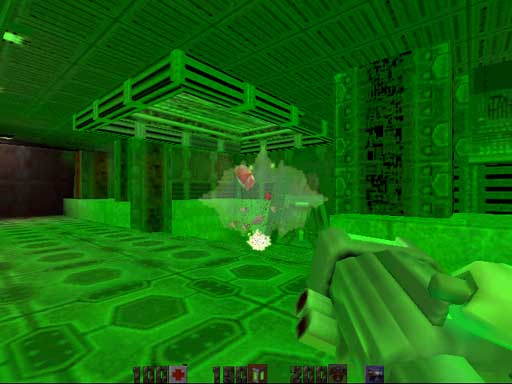 quake2_04.jpg |
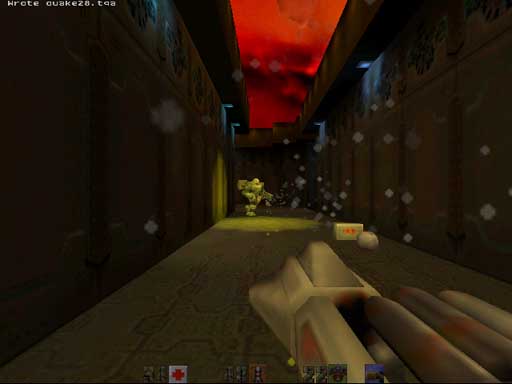 quake2_05.jpg |
|
 quake2_06.jpg |
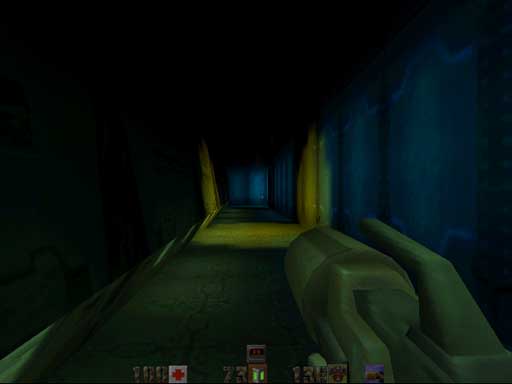 quake2_07.jpg |
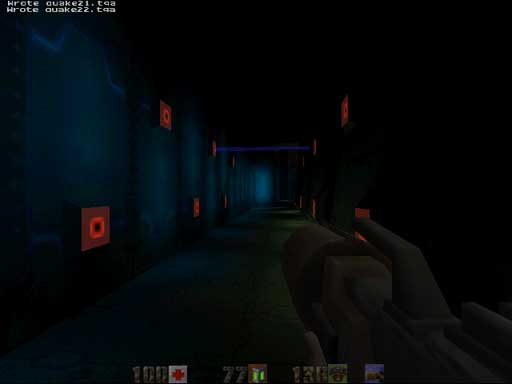 quake2_08.jpg |
 quake2_09.jpg |
Adding to the overall quality of the Viper, Diamond chose to include a few nice goodies with the hardware portion of this card. The Viper V330 features a NTSC TV Output at a 640 x 480 resolution via a composite as well as a S-Video output. Also featured on the Viper is a RCA input, as well as an AC3 port to enable the upgradability to DVD and a TV Tuner if you so desire at a later time. When playing MPEG video on the Viper 330, very rarely do you notice any missed frames or choppy playback even in full screen mode. The MPEG playback of the Viper is among the best of its competitors, and is rivaled by that of Matrox's Millennium and ATI's 3D Xpression+ PC2TV which also features a TV-output.
Update - 12/11/97 - A simple re-run of the Direct Draw benchmarks using Diamonds new driver illustrates a contradiction to the original comment made on this review about the DD performance of the V330 lagging behind that of the competition. The direct draw performance of the Riva 128 chipset is fully accented when using Diamond's new drivers, and the benchmarks below prove that statement fully. NVidia has also released an Alpha version of their GL drivers so you can even run GLQuake/GLQuake 2 on your Viper 330 at resolutions up to 960 x 720! Needless to say, the performance and image quality when running GLQuake/2 on your Viper is absolutely amazing.
Update - It seems as though the Diamond Viper's AVI Video performance isn't all that great, although the quality is excellent, at full screen there have been reports of people receiving as low as 6 fps! On the test system the Viper played back a number of AVI's at an average of about 20 - 25 fps which isn't all that bad although it could be better.


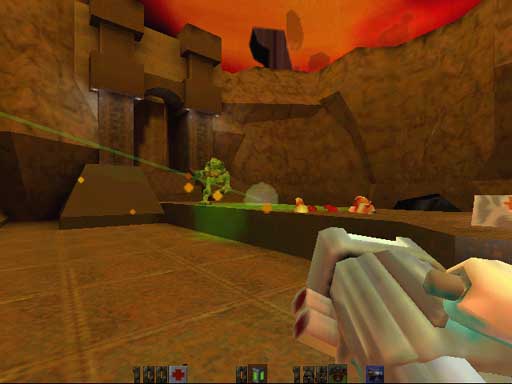








2 Comments
View All Comments
tipoo - Friday, March 18, 2011 - link
This should be added to AT bench!slatanek - Friday, November 30, 2012 - link
It's amazing to see this review! this was my first video card and at that time its performance was awesome for the money. to think that this thing had 4MB of video memory is just mindblowing! Quake 2 indeed looked great on the Riva 128.AnandTech started at almost same time as my interest for PC. Now I got emotional... ;-)